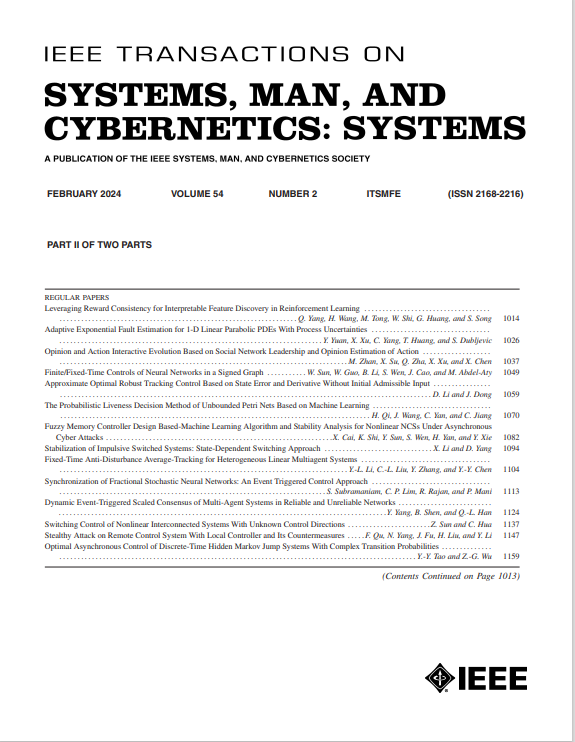DRIFT: A Dynamic Crowd Inflow Control System Using LSTM-Based Deep Reinforcement Learning
IF 8.6
1区 计算机科学
Q1 AUTOMATION & CONTROL SYSTEMS
IEEE Transactions on Systems Man Cybernetics-Systems
Pub Date : 2025-03-27
DOI:10.1109/TSMC.2025.3549627
引用次数: 0
Abstract
Crowd management plays a crucial role in improving travel efficiency and reducing potential risks caused by overcrowding in large public places. Crowd control at entrances is a common way in our daily life to avoid overcrowding, but nowadays the control of crowd inflow at the entrances of public places mainly relies on manual operation. In this article, we intend to propose a dynamic crowd inflow control system (DRIFT) to avoid risks of overcrowding and improve the throughput of public places. First, we formulate an optimization problem that maximizes throughput by adjusting the crowd inflow rate of each entrance in the public place. Through mathematical analysis and related proofs, we introduce a baseline for the aforementioned problem that can calculate the upper bound of static inflow rate. With this baseline, we can easily measure the performance of other dynamic inflow control algorithms. Second, we treat the proposed optimization problem as a real-time decision-making problem, and further propose the DRIFT system based on deep reinforcement learning to address it. Specifically, the strategy of DRIFT is a basic actor-critic framework adapting a shared long short term memory (LSTM) layer to extract scene feature information. Third, we train it through proximal policy optimization (PPO) to improve learning performance. The environment for experiments is a crowd simulation model of OpenAI Gym structure based on real scene data from the 1F floor of the Chengdudong Railway Station and Xizhimen Railway Station. In comparison experiments and ablation experiments, the strategy of our DRIFT outperforms all other comparison strategies, including the most recent strategy using reinforcement learning, in term of system crowd throughput and robustness.基于lstm的深度强化学习的动态人群流入控制系统
人群管理在提高出行效率和减少大型公共场所过度拥挤带来的潜在风险方面发挥着至关重要的作用。在我们的日常生活中,入口处的人群控制是一种常见的避免拥挤的方式,但目前公共场所入口处的人群控制主要依靠人工操作。在本文中,我们打算提出一个动态人群流入控制系统(DRIFT),以避免过度拥挤的风险,提高公共场所的吞吐量。首先,我们制定了一个优化问题,通过调整公共场所各入口的人群流入率来实现吞吐量最大化。通过数学分析和相关证明,我们为上述问题引入了一个基线,可以计算出静态入流速率的上界。有了这个基线,我们可以很容易地衡量其他动态流入控制算法的性能。其次,我们将所提出的优化问题视为实时决策问题,并进一步提出了基于深度强化学习的DRIFT系统来解决该问题。具体来说,DRIFT策略是一个基本的演员评价框架,它采用共享长短期记忆(LSTM)层来提取场景特征信息。第三,我们通过近端策略优化(PPO)来训练它,以提高学习性能。实验环境为OpenAI体育馆结构的人群仿真模型,基于成都东火车站和西直门火车站1层的真实场景数据。在比较实验和消融实验中,我们的DRIFT策略在系统人群吞吐量和鲁棒性方面优于所有其他比较策略,包括使用强化学习的最新策略。
本文章由计算机程序翻译,如有差异,请以英文原文为准。
求助全文
约1分钟内获得全文
求助全文
来源期刊

IEEE Transactions on Systems Man Cybernetics-Systems
AUTOMATION & CONTROL SYSTEMS-COMPUTER SCIENCE, CYBERNETICS
CiteScore
18.50
自引率
11.50%
发文量
812
审稿时长
6 months
期刊介绍:
The IEEE Transactions on Systems, Man, and Cybernetics: Systems encompasses the fields of systems engineering, covering issue formulation, analysis, and modeling throughout the systems engineering lifecycle phases. It addresses decision-making, issue interpretation, systems management, processes, and various methods such as optimization, modeling, and simulation in the development and deployment of large systems.
 求助内容:
求助内容: 应助结果提醒方式:
应助结果提醒方式:


